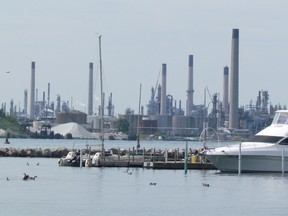Mayor calls claims of secrecy in Chemical Valley 'nonsensical'

Article content
Recent news stories based on an investigation into industrial spills in Chemical Valley have been discouraging for the community, according to Sarnia Mayor Mike Bradley.
“We’ve seen it before, the drive-by reporting,” he said.
“It’s not reflecting where I think we’re getting too and need to be, which is total accountability on the environment” as well as continuing local efforts to encourage bio-based industrial development that moves away from fossil fuels, Bradley added.
“To me, this is about old Sarnia and it’s not about the new Sarnia, and that’s what we’ve got to keep on promoting and moving forward.”
The Toronto Star said the investigation – conducted by itself, Global News, the National Observer and the journalism schools at Ryerson and Concordia – “revealed a troubling pattern of potentially toxic leaks and secrecy in the Chemical Valley.”
The Chemical Valley is the name given to refineries and chemical plants along the St. Clair River south from Sarnia and into St. Clair Township.
“It was the community that has raised concerns in the past about incidents in the Valley and reaction to that, and enforcement,” Bradley said.
“We were the ones pushing for a health study. We wanted this,” he added. “I think the idea that this is some sort of secret going on here is nonsensical.”
Chris Ballard, Ontario’s minister of environment and climate change, said Monday the province is “committed to funding a health study to understand the localized impact of air pollution on Sarnia residents, and will be working with the community in the coming weeks to determine how best to do that.”
Community leaders began pushing back in 2007 for a study into possible health impacts that industry in Sarnia-Lambton has on its residents.
At that time, the Sarnia-Lambton Environmental Association, a non-profit co-operative comprising 20 industrial manufacturers in Sarnia-Lambton, pledged $1.4 million to the study on the condition the balance of its $4.8-million estimate cost was funded by the federal and provincial governments.
When those levels of government didn’t come through after several years of lobbying and grant applications, the health study group began working with independent researchers to look into local health concerns.
Sarnia-Lambton MPP Bob Bailey said he first wrote to the provincial government in 2008, calling for it to support the study, and repeated that call in 2010.
“Those actions went unanswered,” he said. “Here we are, almost 10 years later and the issue has raised its ugly head again.”
Bailey said the province has made statements of support for the community health study in the past “but they never came to the table.”
Bailey said he will continue pushing the province to make good on Monday’s commitment.
“I want a timeline from them,” he said.
Bailey said financial support from the provincial and federal governments is important to ensure the credibility of a study.
“If only industry paid for it there would people say, ‘Oh well, they got the study they wanted,’” he said.
Ontario Environmental Commissioner Dianne Sexe said Monday she was glad to see the provincial government say it will go ahead with a health study.
“But I think it’s at least equally important the ministry also improve its monitoring and regulation of the air pollution that affects the community,” Sexe said.
That topic will be featured in a report the commissioner’s office is scheduled to release next week, she added.
“I’m confident that when they do the study, we’ll find the system is working,” Bailey said, noting industry faces “stiff regulations” in Ontario.
“If we find, when they do this health study, that there’s an issue, then industry and the community will correct it,” he said.
Ballard said data collected by the province at 11 monitoring stations in Sarnia-Lambton shows air quality has been steadily improving over the past 10 years.
He said Sarnia has seen “substantial reductions in emissions of sulphur dioxide, nitrogen dioxide and fine particulate matter.”
The Star and Global investigation raised questions about benzene emissions in the community.
“Benzene levels in Sarnia have greatly decreased compared to what they were in the late ‘80s and early ‘90s,” Ballard said.
“The annual average benzene concentration is now a third of the levels seen 25 years ago.”
Dean Edwardson, general manager of the Sarnia-Lambton Environmental Association, said industries are required by law to report spills.
“My guess is, probably, companies report more than they have to, but that’s OK, that’s what we’re going to do,” he said.
“When the public is in harm’s way, they’re notified.”
Edwardson said that based on the association’s own monitoring in the community, “we see continuous improvement … and we’re going to continue to work to become better.”